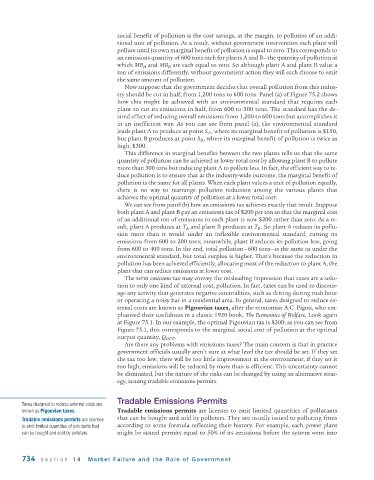Page 776 - Krugmans Economics for AP Text Book_Neat
P. 776
social benefit of pollution is the cost savings, at the margin, to polluters of an addi-
tional unit of pollution. As a result, without government intervention each plant will
pollute until its own marginal benefit of pollution is equal to zero. This corresponds to
an emissions quantity of 600 tons each for plants A and B—the quantity of pollution at
which MB A and MB B are each equal to zero. So although plant A and plant B value a
ton of emissions differently, without government action they will each choose to emit
the same amount of pollution.
Now suppose that the government decides that overall pollution from this indus-
try should be cut in half, from 1,200 tons to 600 tons. Panel (a) of Figure 75.2 shows
how this might be achieved with an environmental standard that requires each
plant to cut its emissions in half, from 600 to 300 tons. The standard has the de-
sired effect of reducing overall emissions from 1,200 to 600 tons but accomplishes it
in an inefficient way. As you can see from panel (a), the environmental standard
leads plant A to produce at point S A , where its marginal benefit of pollution is $150,
but plant B produces at point S B , where its marginal benefit of pollution is twice as
high, $300.
This difference in marginal benefits between the two plants tells us that the same
quantity of pollution can be achieved at lower total cost by allowing plant B to pollute
more than 300 tons but inducing plant A to pollute less. In fact, the efficient way to re-
duce pollution is to ensure that at the industry-wide outcome, the marginal benefit of
pollution is the same for all plants. When each plant values a unit of pollution equally,
there is no way to re arrange pollution reduction among the various plants that
achieves the optimal quantity of pollution at a lower total cost.
We can see from panel (b) how an emissions tax achieves exactly that result. Suppose
both plant A and plant B pay an emissions tax of $200 per ton so that the marginal cost
of an additional ton of emissions to each plant is now $200 rather than zero. As a re-
sult, plant A produces at T A and plant B produces at T B . So plant A reduces its pollu-
tion more than it would under an inflexible environmental standard, cutting its
emissions from 600 to 200 tons; meanwhile, plant B reduces its pollution less, going
from 600 to 400 tons. In the end, total pollution—600 tons—is the same as under the
environmental standard, but total surplus is higher. That’s because the reduction in
pollution has been achieved efficiently, allocating most of the reduction to plant A, the
plant that can reduce emissions at lower cost.
The term emissions tax may convey the misleading impression that taxes are a solu-
tion to only one kind of external cost, pollution. In fact, taxes can be used to discour-
age any activity that generates negative externalities, such as driving during rush hour
or operating a noisy bar in a residential area. In general, taxes designed to reduce ex-
ternal costs are known as Pigouvian taxes, after the economist A.C. Pigou, who em-
phasized their usefulness in a classic 1920 book, The Economics of Welfare. Look again
at Figure 75.1. In our example, the optimal Pigouvian tax is $200; as you can see from
Figure 75.1, this corresponds to the marginal social cost of pollution at the optimal
output quantity, Q OPT .
Are there any problems with emissions taxes? The main concern is that in practice
government officials usually aren’t sure at what level the tax should be set. If they set
the tax too low, there will be too little improvement in the environment; if they set it
too high, emissions will be reduced by more than is efficient. This uncertainty cannot
be eliminated, but the nature of the risks can be changed by using an alternative strat-
egy, issuing tradable emissions permits.
Tradable Emissions Permits
Taxes designed to reduce external costs are
known as Pigouvian taxes. Tradable emissions permits are licenses to emit limited quantities of pollutants
Tradable emissions permits are licenses that can be bought and sold by polluters. They are usually issued to polluting firms
to emit limited quantities of pollutants that according to some formula reflecting their history. For example, each power plant
can be bought and sold by polluters. might be issued permits equal to 50% of its emissions before the system went into
734 section 14 Market Failure and the Role of Gover nment

